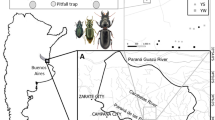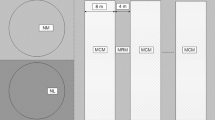Abstract
Because fens have undergone dramatic declines in recent decades, an important question is which management regimes and habitat parameters are most effective in preserving fen biodiversity. The aim of the present study was to assess the effects of five different management regimes (intensive grassland, moist meadows, summer harvested sites, winter harvested sites, fallows) on staphylinid beetle assemblages. During the study period 5,989 individuals from 92 staphylinid beetle species were recorded. Species richness and abundance were highest on intensive grassland and fallows, and water level and vegetation height had significant impacts on the abundance of staphylinids. On winter-harvested sites species richness and abundance were lowest. In general, staphylinid beetles did not show pronounced variation among management regimes, while the environmental factors water level, vegetation height and top soil mineralisation seemed to have a larger structuring impact. The number of threatened species and the conservation index were highest on summer-harvested sites and fallows, representing fairly well-preserved fens. We conclude that summer harvest of reed beds or no management at all appears to be most beneficial for the conservation of staphylinid beetles.



Similar content being viewed by others
References
Andersen A, Eltun R (2000) Long-term developments in the carabid and staphylinid (Col., Carabidae and Staphylinidae) fauna during conversion from conventional to biological farming. J Appl Entomol 124:51–56
Assing V, Schülke M (2011) Freude-Harde-Lohse-Klausnitzer - Die Käfer Mitteleuropas Band 4 Staphylinidae I, 2nd edn. Spektrum Akad Verlag, Heidelb und, Berlin, pp 1–560
Ausden M, Sutherland WJ, James R (2001) The effects of flooding lowland wet grassland on soil macroinvertebrate prey of breeding wading birds. J Appl Ecol 38:320–338
Bakker JP, Berendse F (1999) Constraints in the restoration of ecological diversity in grassland and heathland communities. Trends Ecol Evol 14:63–68
Batáry P, Örvössy N, Kőrösi Á, Nagy MV, Peregovits L et al (2007) Microhabitat preferences of Maculinea teleius (Lepidoptera: Lycaenidae) in a mosaic landscape. Eur J Entomol 104:731–736
Bedford BL, Godwin KS (2003) Fens of the United States: distribution, characteristic, and scientififc connection versus legal isolation. Wetlands 23:608–629
Bohac J (1991) The effect of dispersed belts in agroecosystems on communities of epigeic beetles. In: Mahn EG, Tietze F (eds) Agro-Ökosysteme und Habitatinseln in der Agrarlandschaft. Universität Halle-Wittenberg, Germany, pp 289–294
Bohac J (1999) Staphylinid beetles as bioindicators. Agric Ecosyst Environ 74:357–372
Bohac J, Fuchs R (1994a) Classification and ordination of habitats of staphylinid beetles (Coleoptera, Staphylinidae) in agriculture landscapes of central and east Europe. Abstr. 5th Eur. Congr. Entomol. Univ. York, York, p 30
Bohac J, Fuchs R (1994b) Carabidae and Staphylinidae of Bohemian villages. In: Desender K, Dufrene M, Loreau M, Luff ML, Maelfait J-P (eds) Carabid beetles: ecology and evolution. Kluwer, Dordrecht, pp 235–240
Bohac J, Fuchs R (1996) The long-term investigations of beetles (Coleoptera, Staphylinidae) in Trebon Biosphere reserve. Verhandlungen des 14. Int. Symp. für Entomofaunistik Mitteleuropa, SIEEC, München 1994, SIEEC, München, p 427
Bohac J, Pospisil J (1984) Carabids and staphylinids of wheat and maize fields and their relationships with surrounding biotopes. Soc Rev Ecol 3:22–34
Bohac J, Kubes J, Fuchs R, Curnova A (1995) The use of biomonitoring for ecological planning and ecological policy in agricultural settlements. In: Munawar M, Hanninen O, Roy S, Munawar N, Karelampi L, Brown D (eds) Bioindicators of environmental health. SPB Academic Publishing, Amsterdam, pp 155–163
Charman DJ (2002) Peatlands and environmental change. Wiley, Chichester
Dennis P, Doering J, Stockan JA, Jones JR, Rees ME, Vale JE, Sibbald AR (2004) Consequences for biodiversity of reducing inputs to upland temperate pastures: effects on beetles (Coleoptera) of cessation of nitrogen fertilizer application and reductions in stocking rates of sheep. Grass Forage Sci 59:121–135
Dufrêne M, Legendre P (1997) Species assemblages and indicator species: the need for a flexible assymetrical approach. Ecol Monogr 67:345–366
Ellenberg H, Weber HE, Düll R, Wirth V, Werner W, Pauliben D (1992) Zeigerwerte von Pflanzen in Mitteleuropa. Scr. Geobot. 18. Goltze, Göttingen
Eyre MD, Luff ML (2005) The distribution of epigeal beetle (Coleoptera) assemblages on the north-east England Coast. J Coast Res 215:982–990
Freier B, Volkmar C, Kreuter T, Triltsch H, Stark A, Forster R et al (1999) Nützlinge als Bioindikatoren für die ökologischen Auswirkungen des Pflanzenschutzes in Feldstudien - Methoden und die Probleme bei der Interpretation der Daten. Pest Sci 72:5–11
Freude H, Harde K, Lohse G (1974) Die Käfer Mitteleuropas, vol 5. Goecke & Evers Verlag, Krefeld
Geiser R (1998) Rote Liste der Käfer (Coleoptera). In: Binot M, Bless R, Boye P, Gruttke H, Pretscher P (Bearb.): Rote Liste gefährdeter Tiere Deutschlands. - Schrr. Landschaftspflege Natursch. Bonn-Bad Godesberg, pp 168–230
Görn S, Fischer K (2011) Niedermoore Nordostdeutschlands bewerten - Vorschlag für ein faunistisches Bewertungssystem. Naturschutz und Landschafts planung 43:211–217
Görn S, Fischer K (2015) Measuring the efficiency of fen restoration on carabid beetles and vascular plants: a case study from north-eastern Germany. Restor Ecol 23:413–420
Görn S, Dobner B, Suchanek A, Fischer K (2014) Assessing human impact on fen biodiversity: effects of different management regimes on butterfly, grasshopper, and carabid beetle assemblages. Biodivers Conserv 23:309–326
Görn S, Schulze F, Fischer K (2015) Effects of fen management on bird communities in north-eastern Germany. J Ornithol 156:287–296
Hardman C, Harris D, Sears J, Droy N (2012) Habitat associations of invertebrates in redbeds, with implications for management. Aquat Conserv Mar Freshw Ecosyst 22:813–826
Hennicke F (2001) Das Naturschutzprojekt “Peenetal-Landschaft”. In: Succow M, Joosten H (eds) Landschaftsökologische Moorkunde, 2nd edn. Schweizbart, Stuttgart, pp 487–492
Hofmann TA, Mason CF (2006) Importance of management on the distribution and abundance of Staphylinidae (Insecta: Coleoptera) on coastal grazing marshes. Agric Ecosyst Environ 114:397–406
Joosten H (1997) European mires: a preliminary status report. International Mire Conservation Group Members Newsletter 3:10–13
Joosten H, Clarke D (2002) Wise Use of peatlands. International Mire Conservation Group and International Peat Society, Jyväskylä
Kiehl K, Kirmer A, Donath T, Rasran L, Hölzel L (2010) Species introduction in restoration projects—evaluation of different techniques for the establishment of semi-natural grasslands in Central and Northwestern Europe. Basic Appl Ecol 11:285–299
Klimadaten der DDR (1987) Reihe B. - Band 14 - “Klimatologische Normalwerte 195/80.” Meteorologischer Dienst der DDR, Potsdam
Klimkowska A, Van Diggelen R, Bakker JP, Grootjans AP (2007) Wet meadow restoration in Western Europe: a quantitative assessment of the effectiveness of several techniques. Biol Conserv 140:318–328
Klimkowska A, Van Diggelen R, Grootjans AP, Kotowski W (2010) Prospects for fen meadowrestoration on severely degraded fens. Perspect Plant Ecol Evol Syst 12:245–255
Köhler F, Gürlich S, Bleich O (2015) Onlineportal zum Verzeichnis der Käfer Deutschlands. http://www.coleokat.de/de/fhl
Koivula MJ (2011) Useful model organisms, indicators, or both? Ground beetles (Coleoptera, Carabidae) reflecting environmental conditions. Zookeys 100:287–317
Lamers LPM, Vile MA, Grootjans AP, Acreman MC, van Diggelen R, Evans MG, Richardson CJ, Rochefort L, Kooijman AM, Roelofs JGM, Smolders AJP (2015) Ecological restoration of rich fens in Europe and North America: from trial and error to an evidence-based approach. Biol Rev 90:182–203
Mälson K, Backéus I, Rydin H (2008) Long-term effects of drainage and initial effects of hydrological restoration on rich fen vegetation. Appl Veg Sci 11:99–106
Mälson K, Sundberg S, Rydin H (2010) Peat disturbance, mowing, and ditch blocking as tools in rich fen restoration. Restor Ecol 18:469–478
Martay B, Hughes F, Doberski J (2012) A comparison of created and ancient fenland using ground beetles as a measure of conservation value. Insect Conserv Divers 5:251–263
McCune B, Mefford MJ (1999) Multivariate Analysis of Ecological Data. Version 5.0 MjM Software, Gleneden Beach, Oregon, USA
MLUV (2012) Erhaltung und Entwicklung der biologischen Vielfalt in Mecklenburg-Vorpommern. Landesamt für innere Verwaltung, Schwerin
Neumann D, Krüger M (1991) Schilfhalme im Winter - Überwinterungsquartier für Insekten und Spinnen sowie Nahrungsquelle für insektivore Singvögel. Natur und Landschaft 66:166–168
Schatz I, Kopf T, Steinberger K, Glaser F (2003) Die Kurzflügelkäfer (Coleoptera: Staphylinidae) des Frastanzer Riedes und der angrenzenden Illaue (Vorarlberg, Österreich). Voralberger Naturschau 13(13):239–258
Schmidt MH, Lefebvre G, Poulin B, Tscharntke T (2005) Reed cutting affects arthropod communities, potentially reducing food for passerine birds. Biol Conserv 121:157–166
Staniec B, Pietrykowska-Tudruj E (2008) Morphology of the immature stages and notes on biology of Philonthus nigrita (Gravenhorst, 1806) (Coleoptera, Staphylinidae) a stenotopic species inhabiting Sphagnum peatbogs. Mitteilungen aus dem Museum für Naturkd Berlin - Dtsch Entomol Zeitschrift 55:167–183
StatSoft I (2007) STATISTICA for Windows (software system for data analysis). Version 8.0. www.statsoft.com
Tanneberger F, Wichtmann W (2011) Carbon credits from peatland rewetting. Climate—biodiversity—land use. Science, policy, implementation and recommendations of a pilot project in Belarus. Schweizerbart, Stuttgart
Tanneberger F, Flade M, Preiksa Z, Schröder B (2010) Habitat selection of the globally threatened Aquatic Warbler Acrocephalus paludicola at the western margin of its breeding range and implications for management. Ibis (Lond 1859) 152:347–358
Timmermann T, Wichtmann W, Succow M, Billwitz K (2002) Alternative Nutzungsformen für Moorstandorte in Mecklenburg-Vorpommern. Greifswalder Geographische Arbeiten 31:31–42
Timmermann T, Margóczi K, Takács G, Vegelin K (2006) Restoration of peat-forming vegetation by rewetting species-poor fen grasslands. Appl Veg Sci 9:241–250
Van Diggelen R, Middleton B, Bakker J, Grootjans A, Wassen M (2006) Fens and floodplains of the temperate zone: present status, threats, conservation and restoration. Appl Veg Sci 9:157–162
Wichtmann W, Tanneberger F, Wichmann S, Joosten H (2010) Paludiculture is paludifuture-climate, biodiversity and economic benefits from agriculture and forestry on rewetted peatland. Peatlands Int 1:48–51
Williams CD, Hayes M, Mc Donnell RJ, Anderson R, Bleasdale A, Gormley MJ (2014) Factors affecting wetland ground beetle (Carabidae) assemblages: How important are habitats, conservation designations and management? Insect Conserv Divers 7:206–222
Zedler JB (2000) Progress in wetland restoration ecology. Trends Ecol Evol 15:402–407
Zeitz J, Stegmann H (2001) Moorbodenhorizonte und -typen. In: Succow M, Joosten H (eds) Landschaftsökologische Moorkunde, 2nd edn. Schweizerbart, Stuttgart
Zerbe S, Steffenhagen P, Parakenings K, Timmermann T, Frick A, Gelbrecht J, Zak D (2013) Ecosystem service restoration after 10 years of rewetting peatlands in NE Germany. Environ Manage 51:1194–1209
Acknowledgments
We thank Knut Weidemann, Enrico Hübner, Johannes Weidauer and Wilhelm Linke for their help during field work, Andreas Brisch, Florian Sievers and Rico Kaufmann for the analyses of the peat body and the vegetation, and Sonja Hennicke and Volker Assing for help with the identification of some critical taxa. Financial support was provided by the Federal Ministry of Education and Research (BMBF) within the funding scheme “Sustainable Land Management” (FKZ 033L030).
Author information
Authors and Affiliations
Corresponding author
Appendix
Rights and permissions
About this article
Cite this article
Hoffmann, H., Michalik, P., Görn, S. et al. Effects of fen management and habitat parameters on staphylinid beetle (Coleoptera: Staphylinidae) assemblages in north-eastern Germany. J Insect Conserv 20, 129–139 (2016). https://doi.org/10.1007/s10841-016-9847-0
Received:
Accepted:
Published:
Issue Date:
DOI: https://doi.org/10.1007/s10841-016-9847-0




